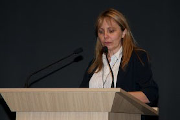students:phd_2019
Differences
This shows you the differences between two versions of the page.
| Both sides previous revisionPrevious revisionNext revision | Previous revision | ||
| students:phd_2019 [2019/05/10 18:32] – [Objectives] blay | students:phd_2019 [2019/05/10 18:40] (current) – [Objectives] blay | ||
|---|---|---|---|
| Line 3: | Line 3: | ||
| // | // | ||
| - | Recent advances in Machine Learning (ML) have brought new solutions for the problems of prediction, decision, and identification. ML is impacting almost all domains of science or industry but determining the right ML workflow for a given problem remains a key question. To allow not only experts in the field to benefit from ML potential, last years have seen an increasing effort from the big data companies (Amazon AWS, Microsoft Azure, Google AutoML...) to provide any user with simple platforms for designing their own ML workflow. However, none of these solutions consider the design of ML workflow as a generic process intending to capture common processing patterns between workflows (even through workflows targeting different application contexts). These platforms either propose a set of dedicated solutions for given classes of problem (i.e. AutoML Vision, AutoML natural language , AutoML Translation...) or propose a recipe to build your own ML workflow from scratch (i.e. MS Azure Machine Learning studio, RapidMiner). | + | Recent advances in Machine Learning (ML) have brought new solutions for the problems of prediction, decision, and identification. ML is impacting almost all domains of science or industry but determining the right ML workflow for a given problem remains a key question. To allow not only experts in the field to benefit from ML potential, last years have seen an increasing effort from the big data companies (Amazon AWS, Microsoft Azure, Google AutoML...) to provide any user with simple platforms for designing their own ML workflow. However, none of these solutions consider the design of ML workflow as a generic process intending to capture common processing patterns between workflows (even through workflows targeting different application contexts). These platforms either propose a set of dedicated solutions for given classes of problem (i.e. AutoML Vision, AutoML natural language , AutoML Translation...) or propose a recipe to build your own ML workflow from scratch (i.e. MS Azure Machine Learning studio, RapidMiner).\\ |
| Is it then possible to envision the meta-learning process of designing ML workflow as a systematic approach analyzing past experiences to identify, explain and predict the right choices? | Is it then possible to envision the meta-learning process of designing ML workflow as a systematic approach analyzing past experiences to identify, explain and predict the right choices? | ||
| This PhD thesis will address this issue by correlating research on software architectures (including product lines) and meta-learning, | This PhD thesis will address this issue by correlating research on software architectures (including product lines) and meta-learning, | ||
| ===== Context ===== | ===== Context ===== | ||
| - | | + | |
| - | To help with this task, Microsoft Azure Machine Learning, Amazon AWS, and RapidMiner Auto Model[12] | + | To help with this task, Microsoft Azure Machine Learning, Amazon AWS, and RapidMiner Auto Model[12] |
| | | ||
| Line 15: | Line 16: | ||
| ===== Objectives ===== | ===== Objectives ===== | ||
| - | The construction of a portfolio requires covering a space of experiments broad enough to " | + | The construction of a portfolio requires covering a space of experiments broad enough to " |
| - | However, (1) the space of problems and solutions presents a very great ((The variability subjects are related to pretreatment, | + | However, (1) the space of problems and solutions presents a very great ((The variability subjects are related to pretreatment, |
| - | (2) The resources required for ML experiments are massive (time, memory, energy)((The number of theoretical experiments to study p pretreatments, | + | (2) The resources required for ML experiments are massive (time, memory, energy)((The number of theoretical experiments to study p pretreatments, |
| - | (3) As the ML domain is particularly productive, the portfolio must be able to evolve to integrate new algorithms. | + | (3) As the ML domain is particularly productive, the portfolio must be able to evolve to integrate new algorithms.\\ |
| (4) To cope with the mass of data, the transformation of experimental results into knowledge requires the implementation of automatic analysis procedures. | (4) To cope with the mass of data, the transformation of experimental results into knowledge requires the implementation of automatic analysis procedures. | ||
| - | The objective of this thesis is, therefore, to propose different paradigms for constructing a portfolio of machine-learning workflows that meet these requirements: | + | The objective of this thesis is, therefore, to propose different paradigms for constructing a portfolio of machine-learning workflows that meet these requirements: |
| The PhD work will be organized to provide contributions in the following directions: \\ | The PhD work will be organized to provide contributions in the following directions: \\ | ||
| 1- A representation of experiments in the form of graphs [10] and exploitation of these structures by adapted learning algorithms[3, | 1- A representation of experiments in the form of graphs [10] and exploitation of these structures by adapted learning algorithms[3, | ||
students/phd_2019.1557513143.txt.gz · Last modified: 2019/05/10 18:32 by blay
